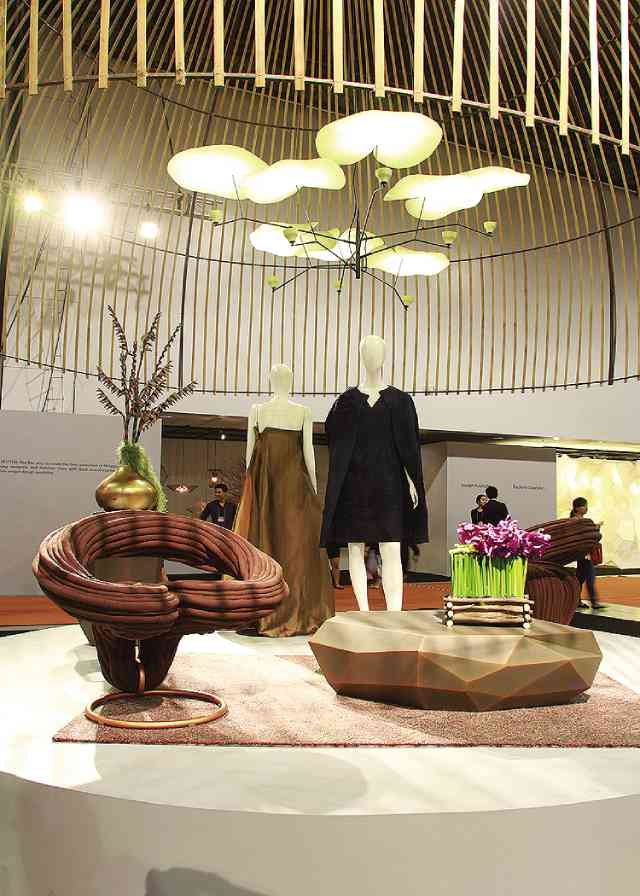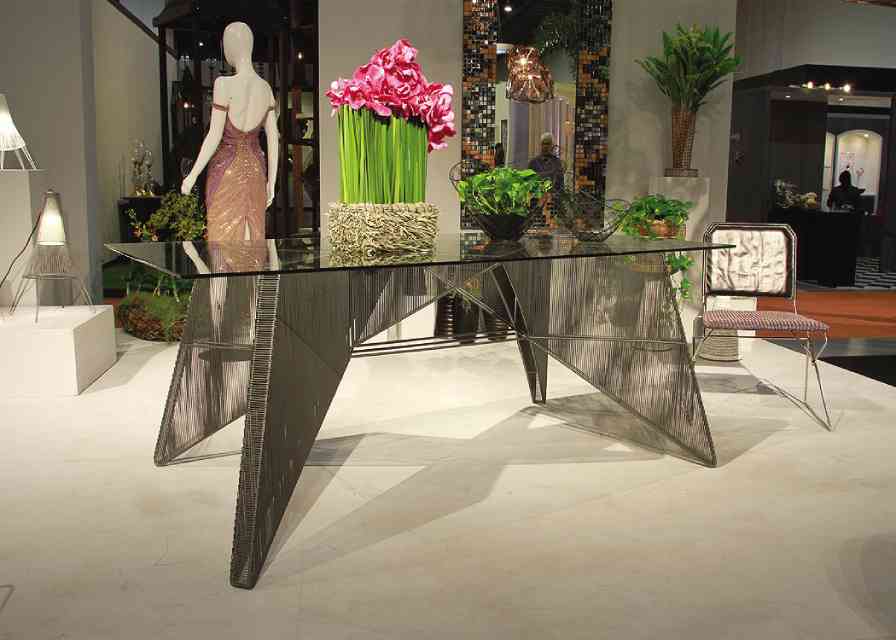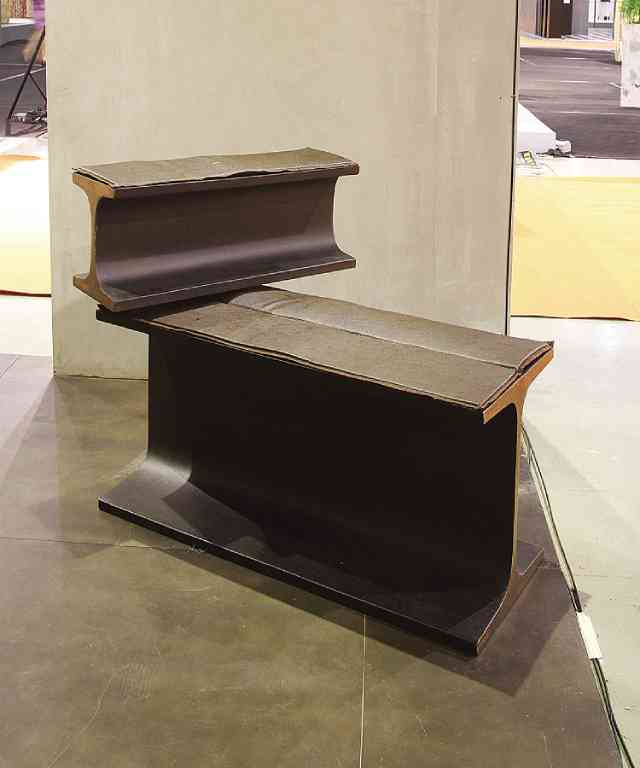
Our trade shows aren’t so much about setting trends as they are about the much-vaunted Filipino creativity and craftsmanship—and the challenges of succeeding in the world market.
The 60th edition of Manila FAME (Furnishings and Apparel Manufacturers’ Exchange), which ends today at the SMX Convention Center, maintains the same old subtext: We’ve got so much talent, but where are we heading?
For Antonio “Budji” Layug, Manila FAME’s creative director, diverse design viewpoints from both seasoned participants and newbies alike are always welcome.
Cebu-based Kenneth Cobonpue’s collection brings to fore the 2015 forecast: blue as the new black. His living room collection echoes the American Indian dessert.
Heralding next season’s look, the sofa and armchair are upholstered in denim with a local twist of rattan trimming. The sofa and chair follow the gentle curves of the native Indian canoe. The bases of the coffee tables mimic the shapes of the cacti, made of steel with copper-finish, another upcoming trend.
As piece de resistance, the tables are topped with ¾-inch glass. The antelope chairs, made of rattan, metal and wood, are playfully decorated with resin antlers.
(Then again, the consumer isn’t just paying for the status of the Kenneth Cobonpue brand but also for the product development. Architect James Jao once said he furnished a client’s house in Tacloban with Cobonpue’s abaca and wire-framed sofa and Yoda chair. They were the few pieces that survived the catastrophic “Yolanda” flooding.)
Curvier contours
Interior designer Eric Paras, one of Manila FAME’s featured consultants, designs a fully embroidered sofa for Catalunia. Classicism will always prevail, he says, interpreted in curvier contours and warm metals.
For Industria, a company known for modern metal designs, Paras designs coffee tables with turned bases. The steel is hand-forged (heated and shaped manually not by machine) to produce a bronze patina.

For leather company Prizmic and Brille, he creates a Campaign Bed, a folding piece with leather straps that complement the mahogany frame. The Old World feel of the bed contrasts with the asymmetrical coffee tables, built with shagreen top and hand-painted gilded base.
Nature and organic inspirations will never go out of style, as shown in Layug’s design of an assemblage of unevenly cut mirrors in a mash of delicate steel twigs, given depth with backlighting. The design, he says, has to be scaled to the space for maximum impact.
Stanley Ruiz, another featured designer for Manila FAME, updates a classic wood-and-paper clock and mirror set for Masaeco paper company by turning them into modular systems. They are composed of groups of triangles and hexagons that can be assembled and reassembled according to the user’s imagination.
Ruiz updates a baroque-inspired chair in black abaca and velvet upholstery for Enpekei International, and takes to the ethnic trend by creating Enpeki’s existing Aztec design into a fiberglass screen divider.
Cebuana designer Luisa Robinson offers candles made from eco-friendly coco-wax and infused with high-end essences. The packaging is equally beautiful, with scented lids made from shells.
Her home line is packaged in delicate bone china. She introduces a new material, Stellcast, which combines stone, shells and a binder to create sinuous vases that resemble angel wings and nautilus shells.
Fresh ideas
Layug cites the importance of the millennials in introducing fresh ideas. At the Red Box, the showcase of promising designers, he cites Rachelle Dagñallan, a 22-year-old industrial design graduate of the University of Sto. Tomas. She updates the traditional parol into a piece of wall décor made of abaca pulp paper.
Handmade in Batangas, the wall installation illustrates the constellations, but when put together, you could have a Christmas lantern.
Dagñalla started as assistant to sculptor-designer Jinggoy Buensuceso. For Manila FAME, she also helps in One Town One Product, the section of native products from provincial backyard industries, helping product development for fossilized flowers, mats and blinds made of buntal fiber. Her aesthetic adds youth appeal to stodgy leather bags.
For Red Box, sculptor Leeroy New creates a wall installation of cardboard jigsaw puzzle pieces. The cardboard comes from Rogare, and the pendant lamp is made from recycled paper and abaca is by Masaeco.

The 28-year-old artist says he enjoys his foray into manufacturing and product design: “I’m learning a different language.”
New collaborates with Cobonpue on the Lily Pad chandelier. Metal sheets are shaped into green water lily pads held by a metal frame. The concept needed Cobonpue’s industrial-design savvy, resulting in sturdy chandelier that produces an illusion of floating lily leaves.
Young designer Lilianna Manahan gets her inspiration for her seater-cum-table for Industria Edition from the construction boom all around. Inspired by the I-beam, the leather seater she makes is shaped like a long steel beam with smaller parallel beam that swivels.
Layug also cites the steel-and-wire frame table with four intersecting triangles as base designed by veteran exporter Celia Jiao of Schema. Light and linear, the table can fit into any interior decor style.
Visual pun
International product design specialist Detlef Klatt works with 17 companies from Pampanga to Davao to produce beautiful tableware. His setting is a visual pun on the chaos of Manila—markers on the floor, dangling cables and distressed tables found in public markets.
They are played against elegant settings with such themes as Serene Luxe, Mother Nature and Urban Wildlife.
The German designer has been doing business in the Philippines since the ’90s. Like most foreigners, he says our advantage is that Filipinos understand the Western market because of the country’s long colonial history.
“Design-wise, Filipinos are creative and very international. There is amazing design elite here. You’ve got me as a foreigner, but you don’t need a foreign consultant but more of someone to kick ass a bit,” says Klett.
Still, he observes that manufacturers and exporters “seem lost. They don’t know which direction to go. Should we go local or export? The challenge is to find their path. That’s where they have to focus on: Who am I, where I am and where do I want to go?”

Undaunted
Ten years ago, Manila FAME was a buyers’ show. But as the number of foreign visitors declined, the trade fair accommodated the public. Thus the businesslike atmosphere has gone the way of a bazaar.
A buyer has said he misses the booths of small-scale entrepreneurs, the backbone of the design industry. Klatt cites another buyer who wanted to get source-quality basic items. He couldn’t find any because most of the booths are now focused on design statements.
But Layug is undaunted. “The most important thing is for us to keep on trying. We have an industry. We need to be supportive and bring it to a sophisticated level. The manufacturers need exposure, imagination and perseverance to bring their products globally and be on the same level with the rest of the world. Without this kind of show, we get complacent. Hopefully, we are getting there.”








































